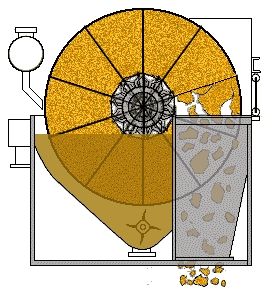The concentrate is filtered on two 8 by 10 ft. Oliver filters. One of these filters is used for each roaster. The filter cake discharges onto a conveyor belt which feeds the charge directly to the roaster.
The concentrate filter cake is at best a sticky, puttylike mass. If the moisture exceeds 20 per cent it becomes difficult to handle the cake on the belt and at the charging chute.
The best filtering technique which could be obtained on the 26 per cent sulphur concentrate produced a cake with from 21 to 22 per cent moisture. This was too sticky for continuous use and introduced an excessive amount of moisture into the furnace, which slowed the commencement of roasting.
To reduce the moisture content of the cake, a device was copied from the Consolidated Mining and Smelting Company in their Sullivan concentrator, which, according to them, was originally developed at Granby. This device consists of a flapper fixed on a revolving shaft parallel to the axis of the filter drum. The flappers are made of old conveyor belt about 12 in. wide and the length of the filter.
The single flapper reduces the moisture from 21 to 22 per cent down to 16 to 17 per cent, at which moisture content the concentrate can be handled and charged with a minimum of difficulty.
The flapper is run in the opposite direction of rotation to the drum. When both were run clockwise, the blow from the flapper tended to stop the drum, making for jerky operation.
The flapper is driven by a 1-hp. motor which is probably more than twice as large as is required, as the same motor was sufficient when two flappers were fitted on the filters.
To prevent the cake from being dislodged by the blows of the flapper, a piece of heavy fabric is usually fastened so that it drags upon the cake as the drum revolves and receives the blows given by the flapper.
The blows cause a rearrangement of the particles in the cake, closing the cracks and liberating moisture, which is then drawn through into the vacuum system.
